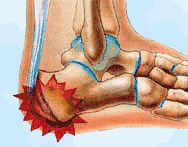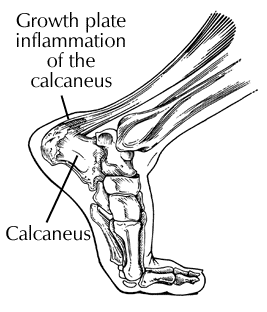 As summer comes to an end and fall season’s start, many parents face unexpected injuries to their favorite players. I’m not talking about the Jacksonville Jaguars, though their O-line has its fair share of injuries, I’m referring to our middle school super-stars. These young athletes seem to have grown a foot over summer, return to the school sports and are benched by heel pain. A feeling of tightness throughout the foot and pain, specifically in the heel, can be caused from the bones of the foot growing faster than the muscles and ligaments. The heel ossifies (turns into bone) later that the other foot bones, so children that play sports (most commonly soccer or basketball) and are very active are more likely to develop pain here. The pain is caused from a repeated stress, such as running or jumping, on the growth plate in the heel, and is a sign of Sever’s disease. Sever’s disease, medically called Calcaneal Apophysitis, is an inflammation caused by stress on the growth plate in the heel and is very common in children. The pain is generally worse after physical activity, and commonly located on the side or back of the heel. This is unlike another common condition, plantar fasciitis, which is worse after long periods of inactivity. Sever’s will go away on its own in most children, but it may take a while. There are several simple options we can offer to confirm the diagnosis, eliminate the pain and shorten recovery so kids don’t miss the fall sports season. A fracture of the heel has very similar symptoms so if the pain is chronic, or does not subside with conservative treatments it should definitely be looked at by a podiatrist.
As summer comes to an end and fall season’s start, many parents face unexpected injuries to their favorite players. I’m not talking about the Jacksonville Jaguars, though their O-line has its fair share of injuries, I’m referring to our middle school super-stars. These young athletes seem to have grown a foot over summer, return to the school sports and are benched by heel pain. A feeling of tightness throughout the foot and pain, specifically in the heel, can be caused from the bones of the foot growing faster than the muscles and ligaments. The heel ossifies (turns into bone) later that the other foot bones, so children that play sports (most commonly soccer or basketball) and are very active are more likely to develop pain here. The pain is caused from a repeated stress, such as running or jumping, on the growth plate in the heel, and is a sign of Sever’s disease. Sever’s disease, medically called Calcaneal Apophysitis, is an inflammation caused by stress on the growth plate in the heel and is very common in children. The pain is generally worse after physical activity, and commonly located on the side or back of the heel. This is unlike another common condition, plantar fasciitis, which is worse after long periods of inactivity. Sever’s will go away on its own in most children, but it may take a while. There are several simple options we can offer to confirm the diagnosis, eliminate the pain and shorten recovery so kids don’t miss the fall sports season. A fracture of the heel has very similar symptoms so if the pain is chronic, or does not subside with conservative treatments it should definitely be looked at by a podiatrist.  We at First Coast Foot and Ankle Cliniccan offer several options for treating and preventing Sever’s disease. Children’s arch supportsare recommended for those who have not yet experienced the severe pain, but are at risk because of their participation in sports or high activity level. Children’s arch supports are commercially available or can be custom fitted by us and will fit into athletic shoes or cleats. It is also important to choose an athletic shoe that supports the child’s arch since it is still developing. Heel cushions can be a good option for children already experiencing the heel pain. Icing for 20-30 minutes after strenuous activity and stretching exercises for the calf muscles will help alleviate the pain and decrease the chance of it returning. Temporarily decreasing the activity level, specifically activities that include jumping or running, may also be required in order to let the area heal. Let us help heal your pain, make an appointment to get your kid back in the game.
We at First Coast Foot and Ankle Cliniccan offer several options for treating and preventing Sever’s disease. Children’s arch supportsare recommended for those who have not yet experienced the severe pain, but are at risk because of their participation in sports or high activity level. Children’s arch supports are commercially available or can be custom fitted by us and will fit into athletic shoes or cleats. It is also important to choose an athletic shoe that supports the child’s arch since it is still developing. Heel cushions can be a good option for children already experiencing the heel pain. Icing for 20-30 minutes after strenuous activity and stretching exercises for the calf muscles will help alleviate the pain and decrease the chance of it returning. Temporarily decreasing the activity level, specifically activities that include jumping or running, may also be required in order to let the area heal. Let us help heal your pain, make an appointment to get your kid back in the game.
Share this article